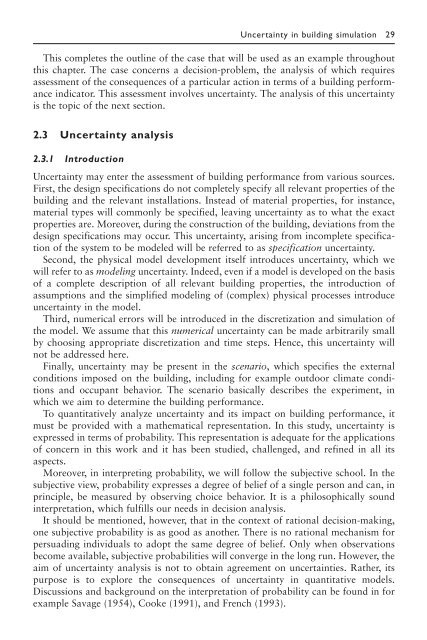Advanced Building Simulation
Advanced Building Simulation
Advanced Building Simulation
You also want an ePaper? Increase the reach of your titles
YUMPU automatically turns print PDFs into web optimized ePapers that Google loves.
This completes the outline of the case that will be used as an example throughout<br />
this chapter. The case concerns a decision-problem, the analysis of which requires<br />
assessment of the consequences of a particular action in terms of a building performance<br />
indicator. This assessment involves uncertainty. The analysis of this uncertainty<br />
is the topic of the next section.<br />
2.3 Uncertainty analysis<br />
Uncertainty in building simulation 29<br />
2.3.1 Introduction<br />
Uncertainty may enter the assessment of building performance from various sources.<br />
First, the design specifications do not completely specify all relevant properties of the<br />
building and the relevant installations. Instead of material properties, for instance,<br />
material types will commonly be specified, leaving uncertainty as to what the exact<br />
properties are. Moreover, during the construction of the building, deviations from the<br />
design specifications may occur. This uncertainty, arising from incomplete specification<br />
of the system to be modeled will be referred to as specification uncertainty.<br />
Second, the physical model development itself introduces uncertainty, which we<br />
will refer to as modeling uncertainty. Indeed, even if a model is developed on the basis<br />
of a complete description of all relevant building properties, the introduction of<br />
assumptions and the simplified modeling of (complex) physical processes introduce<br />
uncertainty in the model.<br />
Third, numerical errors will be introduced in the discretization and simulation of<br />
the model. We assume that this numerical uncertainty can be made arbitrarily small<br />
by choosing appropriate discretization and time steps. Hence, this uncertainty will<br />
not be addressed here.<br />
Finally, uncertainty may be present in the scenario, which specifies the external<br />
conditions imposed on the building, including for example outdoor climate conditions<br />
and occupant behavior. The scenario basically describes the experiment, in<br />
which we aim to determine the building performance.<br />
To quantitatively analyze uncertainty and its impact on building performance, it<br />
must be provided with a mathematical representation. In this study, uncertainty is<br />
expressed in terms of probability. This representation is adequate for the applications<br />
of concern in this work and it has been studied, challenged, and refined in all its<br />
aspects.<br />
Moreover, in interpreting probability, we will follow the subjective school. In the<br />
subjective view, probability expresses a degree of belief of a single person and can, in<br />
principle, be measured by observing choice behavior. It is a philosophically sound<br />
interpretation, which fulfills our needs in decision analysis.<br />
It should be mentioned, however, that in the context of rational decision-making,<br />
one subjective probability is as good as another. There is no rational mechanism for<br />
persuading individuals to adopt the same degree of belief. Only when observations<br />
become available, subjective probabilities will converge in the long run. However, the<br />
aim of uncertainty analysis is not to obtain agreement on uncertainties. Rather, its<br />
purpose is to explore the consequences of uncertainty in quantitative models.<br />
Discussions and background on the interpretation of probability can be found in for<br />
example Savage (1954), Cooke (1991), and French (1993).

















